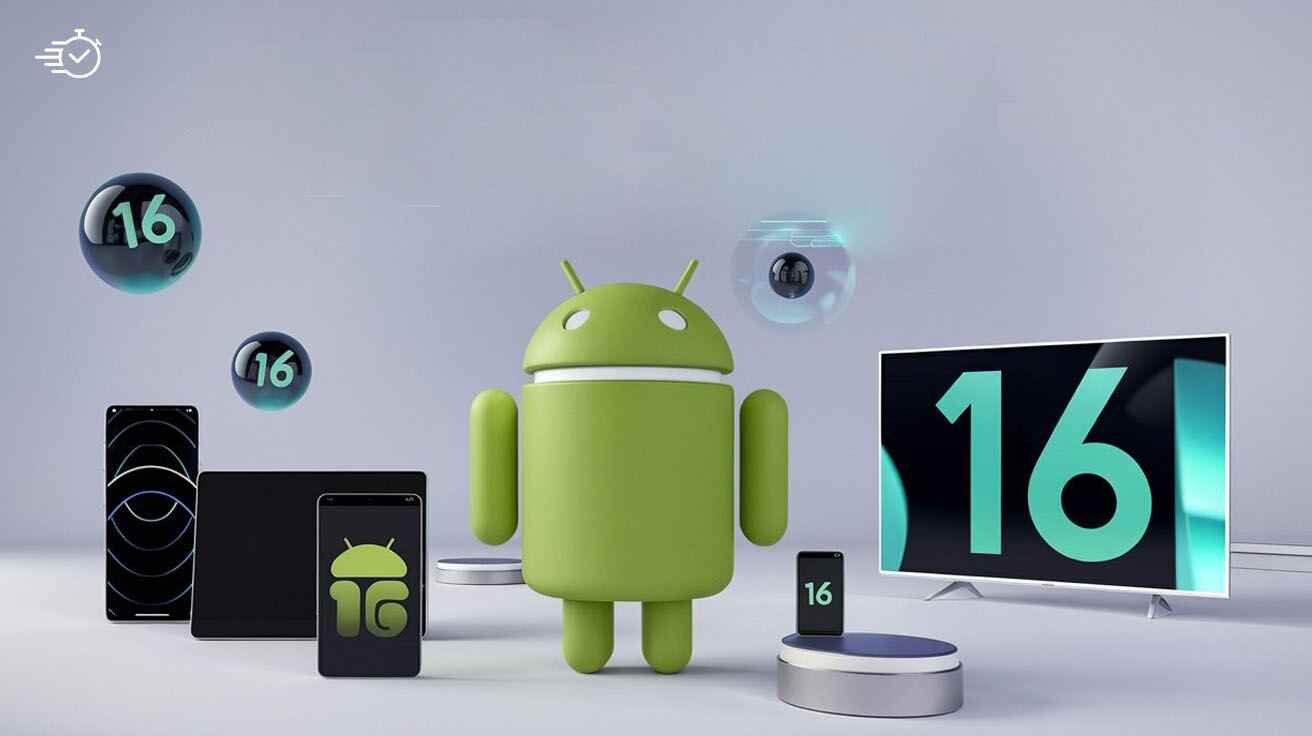Introduction
Overview of the Android Operating System
The Android operating system has been a cornerstone of mobile technology since its inception in 2008. What began as a basic mobile OS with Android 1.0 has grown into a sophisticated ecosystem that powers billions of devices worldwide. Android is not limited to smartphones; it extends its versatility to tablets, smart TVs, wearables, and even automotive systems. Over the years, each version of Android has introduced revolutionary changes, from multi-window support and enhanced security protocols to seamless integration with artificial intelligence (AI) and the Internet of Things (IoT).
Android’s continuous evolution has cemented its position as the world’s most popular mobile operating system, a title achieved through its commitment to innovation, user-centric design, and an open ecosystem that welcomes creativity from developers and manufacturers alike.
Introduction to Android 16
As we stand on the brink of the Android 16 release, it’s clear that this version is set to redefine what’s possible in mobile technology. Android 16 promises to deliver advanced features that will enhance how users interact with their devices while empowering developers to build smarter, more secure applications.
From a Privacy Sandbox aimed at giving users greater control over their data to AI-driven tools that personalize the experience, Android 16 is a monumental step forward. This update isn’t just about incremental improvements—it’s about transforming the way we connect, communicate, and create. Whether it’s the enhanced capabilities for foldable and rollable devices, simultaneous audio sharing with Auracast, or innovative health and wellness features, Android 16 is designed to meet the demands of a rapidly changing tech landscape.
Staying Updated with OS Advancements
Staying informed about operating system advancements like Android 16 is crucial in today’s fast-paced digital world. Mobile operating systems are more than just software; they’re the foundation upon which modern technology operates. Here’s why keeping up with the latest updates matters:
- Improved Performance
Each new Android version introduces optimizations that enhance speed, efficiency, and multitasking. For instance, Android 16 is expected to bring better support for devices with advanced form factors, ensuring a smoother user experience for foldable and rollable screens. - Enhanced Security
As cyber threats evolve, so do security measures. Android 16’s advancements in privacy, like the Privacy Sandbox, help safeguard user data, making it more challenging for malicious actors to exploit vulnerabilities. - Access to New Features
From rich ongoing notifications to AI-powered assistants, staying updated ensures users can enjoy cutting-edge tools and functionalities that enhance convenience and productivity. - Relevance for Developers and Manufacturers
Developers need to stay ahead of the curve to adapt their apps to new APIs and tools, ensuring compatibility and leveraging features to create innovative solutions. Similarly, manufacturers rely on OS advancements to design devices that meet consumer expectations and maintain a competitive edge.
Android 16 represents not just the next chapter in the Android journey but a leap forward into the future of mobile innovation. By understanding its evolution and embracing its new possibilities, users, developers, and manufacturers alike can ensure they remain at the forefront of the digital age.
The Journey to Android 16
Historical Context: From Android 1.0 to Android 15
The journey of the Android operating system began in 2008 with the release of Android 1.0. This initial version, though rudimentary by today’s standards, laid the groundwork for a platform that would eventually dominate the mobile OS market. Early versions introduced basic features like the notification drawer, widgets, and support for Google apps such as Gmail and Google Maps.
As Android evolved, each new version brought significant advancements:
- Android 4.0 (Ice Cream Sandwich) in 2011 introduced a unified design language with Holo UI, bridging the gap between smartphones and tablets.
- Android 5.0 (Lollipop) in 2014 marked a major shift with Material Design, revolutionizing the visual appeal and user interface of Android.
- Android 10 in 2019 brought gesture-based navigation and a system-wide dark mode, enhancing usability and energy efficiency.
- Android 12 in 2021 introduced the personalized Material You design, which dynamically adapts the interface based on the user’s wallpaper and preferences.
- Android 15 further refined multitasking, IoT integration, and foldable device performance, setting the stage for the innovations of Android 16.
Each step in this timeline reflects Android’s commitment to evolving in response to technological advancements and user demands.
Expected Features and Innovations in Android 16
Android 16 is shaping up to be a transformative release, integrating advanced features that cater to the needs of modern users, developers, and manufacturers. With an emphasis on privacy, AI-driven functionality, health integration, connectivity, and user experience, Android 16 promises to redefine what mobile operating systems can achieve.
Enhanced Privacy and Security
Privacy Sandbox Advancements
Privacy remains a top priority for Android 16, and the introduction of the Privacy Sandbox is a game-changer. The Privacy Sandbox creates a secure framework for user data protection while still enabling essential app functionalities like personalized ads or content recommendations. This new approach minimizes cross-app tracking and provides a safer, more transparent digital environment. For instance:
- Apps can interact with anonymized data through secure APIs, ensuring that sensitive information never leaves the device.
- Developers can still offer tailored experiences without compromising user trust.
This advancement reflects Google’s long-term vision of empowering users to maintain control over their personal information without sacrificing usability or functionality.
New Permission Systems and Anonymization Features
Building on the privacy improvements of previous versions, Android 16 introduces advanced permission systems:
- Granular Permissions: Users can allow temporary access to sensitive data, such as location or camera, with permissions that automatically expire.
- Enhanced Alerts: The system will provide clearer, more detailed notifications when apps request high-risk permissions, making it easier for users to make informed decisions.
- Device-Level Anonymization: Android 16 uses advanced anonymization techniques to mask device-specific identifiers, ensuring that apps cannot link data back to the user or their device uniquely.
These features collectively strengthen Android’s position as a privacy-first operating system.
AI-Powered Functionality
Integration of Generative AI for Smarter Assistance
Generative AI is one of the hallmark innovations in Android 16. This cutting-edge technology powers smarter and more intuitive digital assistants that can:
- Compose emails, create summaries, or draft responses based on minimal input from the user.
- Offer dynamic in-app suggestions, such as generating custom playlists, recommending recipes, or crafting social media captions.
- Provide context-aware assistance, like suggesting replies in messaging apps or automatically setting reminders based on user behavior.
This level of integration transforms the way users interact with their devices, making the experience more natural, seamless, and efficient.
Improved Machine Learning Capabilities for Personalization
Machine learning (ML) plays a significant role in Android 16, delivering enhanced personalization and predictive capabilities. Key advancements include:
- Contextual Predictions: The system learns user habits over time, offering proactive suggestions like predicting which app you’re likely to use next or preloading frequently accessed files.
- On-Device Processing: By processing ML algorithms locally, Android 16 ensures faster response times and enhanced privacy since data remains on the device.
- Adaptability Across Devices: The personalized experience extends across multiple Android devices, ensuring a consistent, tailored interface whether on a smartphone, tablet, or wearable.
Health and Wellness Features
Embedded Support for FHIR-Based Health Records
Android 16 introduces native support for FHIR (Fast Healthcare Interoperability Resources), enabling seamless health data management. This innovation allows users to:
- Securely store their medical records, prescriptions, and lab results directly on their devices.
- Share health data with apps or healthcare providers while maintaining control over what information is shared.
- Access real-time health insights that integrate with wearables and health tracking devices.
This feature not only simplifies healthcare management but also positions Android 16 as a vital tool for medical professionals and patients alike.
New Features for Mental Well-Being and Fitness Tracking
Android 16 emphasizes mental health and fitness with innovative features:
- Mindfulness Tools: The system includes guided meditation exercises, reminders to take breaks, and mood-tracking capabilities to support mental well-being.
- Advanced Fitness Integration: From tracking sleep quality to offering personalized workout plans, Android 16 works seamlessly with fitness apps and wearables to deliver actionable insights.
- Stress Management Assistance: By analyzing heart rate and activity levels, Android 16 can provide tailored suggestions for managing stress or improving relaxation.
Connectivity and Sharing
Auracast for Simultaneous Audio Streaming
The introduction of Auracast in Android 16 revolutionizes how users share and consume audio content. This Bluetooth-based technology allows multiple devices to stream the same audio simultaneously, making it perfect for:
- Group Listening: Share music, podcasts, or videos with friends without needing separate audio equipment.
- Public Announcements: Enable users to connect to Auracast-compatible systems in public spaces like airports or museums for real-time updates.
- Enhanced Accessibility: Support for hearing aids or assistive devices ensures inclusive audio experiences for all users.
Improved Multi-Device and IoT Integration
Android 16 further blurs the line between devices by enhancing its multi-device connectivity:
- Unified Ecosystem: Begin a task on one device (e.g., drafting an email on your phone) and seamlessly continue it on another (e.g., finalizing it on a tablet).
- Smarter IoT Controls: Control smart home devices with advanced automation features, such as setting routines based on location or time.
- Wearable Syncing: Android 16 ensures wearables like smartwatches and fitness bands integrate flawlessly with smartphones for real-time notifications and data sharing.
User Experience Enhancements
Optimized Performance for Foldable and Rollable Screens
As foldable and rollable screens gain popularity, Android 16 optimizes the user interface to fully leverage these form factors. Expect features like:
- Adaptive App Layouts: Apps automatically resize and reorient to fit both folded and unfolded states seamlessly.
- Drag-and-Drop Multitasking: Effortlessly move content between split screens or windows, boosting productivity on foldable devices.
Advanced Multitasking Capabilities
Multitasking becomes more powerful and intuitive in Android 16 with:
- Floating App Bubbles: Interact with multiple apps simultaneously, such as keeping a messaging app open while watching a video.
- Quick Switcher: Easily swap between apps in a split-screen or floating window setup without disrupting workflows.
- Collaborative Features: Support for real-time collaboration in apps like document editing tools, making Android 16 ideal for work and productivity.
Android 16 is not just a step forward; it’s a leap into a more connected, intelligent, and user-friendly digital world. With its unparalleled focus on privacy, AI integration, health tracking, connectivity, and usability, Android 16 sets a new benchmark for mobile operating systems. It’s a reflection of how technology can simplify, secure, and enrich our lives, making it a truly exciting update for all Android users.
Release Timeline for Android 16
Overview of the Developer Preview Release
The journey to the official release of Android 16 begins with the Developer Preview, a pre-release version aimed at app developers and enthusiasts. Typically released months ahead of the final version, this preview allows developers to test new features, explore API changes, and optimize their apps for compatibility with the upcoming operating system.
Key highlights of the Developer Preview:
- Early access to Privacy Sandbox enhancements, AI-powered APIs, and multitasking improvements.
- Documentation and developer tools for adopting advanced features like Auracast and foldable device optimizations.
- Feedback mechanisms for developers to report bugs and suggest refinements, helping Google polish the final release.
The Developer Preview sets the stage for an exciting release, giving both developers and tech enthusiasts a glimpse into Android 16’s transformative potential.
Expected Public Beta Phases
Following the Developer Preview, Google typically rolls out Public Beta versions in multiple phases. These versions are more stable and allow a broader audience, including non-developers, to experience Android 16. Here’s what users can expect from the beta rollout:
- Phase 1: Initial beta introduces core features, such as the revamped Settings homepage and Privacy Sandbox, focusing on functional stability.
- Phase 2 and Beyond: Subsequent betas refine the user interface, address bugs, and implement feedback from early testers. Features like advanced screen recording and notification cooldown may debut in later beta phases.
- Compatibility with select devices, particularly Google Pixel phones, ensures users can test Android 16 on real hardware.
The beta phase is crucial for ironing out issues and ensuring a seamless experience for users when the official version launches.
Official Release Date Projection
While Google has yet to announce an official release date for Android 16, based on past trends, the final version is likely to debut in Q4 2024. The release will coincide with the launch of new Pixel devices, showcasing Android 16’s full capabilities. Key milestones in the timeline include:
- June-August 2024: Public beta phase for refining features and gathering feedback.
- October 2024: Official unveiling of Android 16 alongside flagship Pixel devices.
- Late 2024: Gradual rollout to other manufacturers and devices.
How Android 16 Impacts Users
Benefits for Regular Users: Speed, Security, and Convenience
Android 16 is designed with the end user in mind, offering significant improvements in performance, privacy, and ease of use.
- Faster Performance: Optimizations for foldable and rollable screens, combined with better multitasking capabilities, ensure smoother operations across all devices.
- Enhanced Security: With features like the Privacy Sandbox, Android 16 provides better control over personal data and prevents unauthorized tracking.
- Convenience Upgrades: Innovations like Auracast, advanced notification cooldowns, and personalized AI-powered assistants simplify daily tasks and improve the overall user experience.
New Possibilities for Developers and App Integration
Android 16 opens up exciting opportunities for developers to create smarter, more innovative apps:
- Generative AI Integration: Developers can harness new APIs to offer dynamic in-app suggestions and smarter automation tools.
- Health Data Compatibility: Apps can now integrate with FHIR-based health records, enabling better healthcare solutions.
- Enhanced IoT Support: Developers can build apps that seamlessly interact with IoT devices, offering users greater control over smart homes and wearables.
Implications for Manufacturers and Device Updates
Manufacturers benefit from Android 16’s focus on adaptability and device compatibility.
- Foldable Device Optimization: Android 16 ensures that OEMs can deliver cutting-edge devices with superior multitasking and performance.
- Timely Updates: With Android’s Project Treble initiative, manufacturers can push updates faster, ensuring users receive the latest features without delays.
Comparison with Previous Versions
Side-by-Side Comparison of Android 16 and Android 15
| Feature | Android 15 | Android 16 |
| Privacy Features | Basic privacy controls | Advanced Privacy Sandbox, permission expiration, and anonymization tools. |
| AI Capabilities | Limited AI enhancements | Integration of Generative AI for smarter assistance and personalized experiences. |
| Multitasking | Standard split-screen functionality | Advanced floating app bubbles and better multitasking on foldable screens. |
| Audio Sharing | Standard Bluetooth audio sharing | Auracast for simultaneous multi-device audio streaming. |
| Health Integration | Basic fitness tracking | Embedded support for FHIR-based health records and advanced mental health tools. |
| Device Compatibility | Optimized for smartphones and tablets | Enhanced for foldable, rollable, and IoT devices. |
Key Improvements and Areas of Focus
Android 16 builds on the strengths of its predecessor while introducing groundbreaking innovations:
- Privacy Revolution: The introduction of the Privacy Sandbox positions Android 16 as the most secure version yet.
- AI-Powered Features: Generative AI transforms user interaction, making the experience more intuitive and personalized.
- Universal Connectivity: From Auracast to improved IoT integration, Android 16 ensures seamless interactions across devices.
- Hardware Compatibility: With optimized support for foldable and rollable screens, Android 16 leads the way in the next generation of mobile hardware.
Android 16, Google’s upcoming operating system, codenamed “Baklava”, introduces groundbreaking features aimed at enhancing functionality, user engagement, and compatibility across devices. Here’s a thorough exploration of everything you need to know about Android 16, from its standout features to the challenges in its adoption.
Key Features in Android 16
Desktop Windowing for Multitasking
The desktop windowing feature in Android 16 brings a PC-like experience to mobile devices. This functionality allows users to:
- Open apps in resizable windows, which can be dragged and adjusted freely.
- Work with multiple apps side-by-side, making it easier to multitask.
- Use floating bubbles to interact with notifications or perform quick actions without leaving their current tasks.
This feature is a boon for professionals who use tablets or foldable devices for productivity. Imagine working on a spreadsheet while referencing a document in another window or attending a video call while taking notes simultaneously. These improvements promise to redefine mobile multitasking.
Also Checkout: How to Activate FCoE on QLogic BCM57810 in Windows
Redesigned Settings Homepage
Android 16’s settings page has undergone a complete overhaul for better usability. Key highlights include:
- A segmented layout where categories are logically grouped.
- The Google Account section is prominently placed at the top, ensuring quick access to user-specific settings like payments, backups, and connected services.
- System settings such as “About Phone” and “Security & Privacy” are now more intuitively located, reducing the time users spend navigating.
This redesign reflects a user-centered approach, ensuring a cleaner interface and smoother experience. With inspiration drawn from other operating systems like iOS, Android 16 achieves a balance between familiarity and innovation.
Advanced Notification Management
Android 16 brings significant improvements to how notifications are handled. Here’s what users can expect:
- Rich Ongoing Notifications: These notifications now provide in-depth updates and interactive options directly in the panel. For instance, music notifications let users adjust playback without opening the app.
- Notification Cooldown: Introduced to reduce the stress of repeated alerts, this feature mutes continuous notifications for apps that send frequent updates. This is particularly helpful for managing alerts during meetings or focus times.
- Compact Heads-Up Notifications: These are less intrusive and occupy minimal screen space, ensuring users can stay focused while still being informed.
By refining notification management, Android 16 makes it easier to maintain productivity without compromising on essential updates.
New Modes for Customization
Replacing the traditional Do Not Disturb (DND) mode, Android 16 introduces Modes, which are fully customizable profiles for different scenarios. For example:
- Work Mode: Automatically silences personal notifications, blocks gaming apps, and allows only work-related calls.
- Gaming Mode: Enhances performance by limiting background processes and blocking interruptions.
- Weekend Mode: Enables personalized notification settings and adjusts app priorities for a relaxing experience.
Each mode can have a unique icon, personalized behavior, and quick access via the Quick Settings panel. This approach mirrors iOS’s Focus Modes, taking Android’s customization to the next level.
Bluetooth Audio Sharing
With Bluetooth Audio Sharing, users can now share audio with multiple devices simultaneously. This feature allows:
- Streaming music or videos to two or more headphones at the same time.
- Sharing audio using a QR code for quick and easy connectivity.
Although the feature requires Bluetooth LE-supported headphones, its potential applications are exciting—whether sharing music with a friend or using multiple speakers for an enhanced audio experience.
Experimental Display Color Mode
Android 16 introduces a new Experimental Display Color Mode, which provides:
- Enhanced control over color temperature, allowing users to adjust display warmth and coolness.
- Automatic adjustments to reduce eye strain during prolonged use or in low-light environments.
This feature ensures better viewing experiences, whether for gaming, streaming, or reading.
Wi-Fi Sharing Enhancements
Sharing Wi-Fi has never been easier, thanks to the improved design of the Wi-Fi Sharing feature. Users can:
- Generate dynamic QR codes for network sharing, now with an animated, visually appealing interface.
- Avoid lengthy password inputs by directly scanning the code from any device.
These enhancements simplify the process, especially in collaborative spaces like offices, cafes, and homes.
Advanced Functionalities in Android 16

Android 16 introduces a range of features aimed at enhancing user productivity and accessibility. From advanced gesture controls to improvements for smart TVs, this version seeks to unify user experience across devices. Let’s dive deeper into the functionalities and challenges associated with this groundbreaking update.
Gesture-Based Assistant Access
The introduction of gesture-based assistant access in Android 16 simplifies the way users interact with their devices.
- How It Works: A quick corner swipe gesture from the bottom of the screen launches the default assistant. This eliminates the need for button presses or voice activation in noisy environments.
- Key Benefits:
- Multitasking Made Easy: Users can quickly ask questions, set reminders, or manage tasks without interrupting their workflow.
- Accessibility Improvement: The gesture is especially beneficial for individuals with disabilities or mobility challenges, as it provides hands-free assistance.
- Customizable Gestures: Android 16 allows users to customize the sensitivity and area of the gesture, ensuring it doesn’t interfere with other swipe actions.
This feature demonstrates Android’s commitment to seamless usability while maintaining customization options for diverse user needs.
Keyboard Shortcut Menu
The inclusion of a dedicated shortcut menu enhances the productivity of users who rely on physical keyboards with Android tablets or hybrids.
- Features and Functionalities:
- Quick Access to Essential Functions: The shortcut menu provides instant access to functions like taking screenshots, switching apps, adjusting volume, and toggling Wi-Fi or Bluetooth.
- Customization for Power Users: Advanced users can create personalized shortcuts, enabling rapid execution of frequently used commands.
- Target Audience: This feature is particularly useful for:
- Professionals who use Android tablets as laptop replacements.
- Gamers require swift control over device settings.
By integrating keyboard shortcuts, Android 16 transforms tablets and hybrids into powerful productivity tools, bridging the gap between mobile and desktop experiences.
Pixel-Specific Features
Google’s Pixel devices always showcase the best of Android, and Android 16 is no exception. These exclusive features highlight the close integration of hardware and software in Pixel devices.
Manual Charging Limit
- What It Does: Pixel users can now limit battery charging to 80%. This is particularly helpful for users who charge their devices overnight or leave them plugged in for extended periods.
- Benefits:
- Extended Battery Lifespan: By capping the charge, the feature reduces stress on the battery, enhancing its long-term performance.
- Energy Efficiency: Prevents unnecessary power consumption when the battery is near full charge.
- How to Enable: Users can access this setting through Battery Preferences, where they can toggle the manual charging limit.
This feature underscores Android’s commitment to sustainability and device longevity, giving users more control over their devices’ health.
Redesigned Wallpaper App
The redesigned wallpaper app for Pixel devices offers unparalleled customization:
- AI-Powered Wallpapers: Using machine learning, the app generates wallpapers tailored to user preferences, including color schemes, patterns, and themes.
- Dynamic Themes: Wallpapers can now change based on time of day, ambient lighting, or weather conditions, creating a truly immersive experience.
- Accessibility: The app supports high-contrast themes for visually impaired users, ensuring inclusivity.
These updates enhance the personalization aspect of Pixel devices, making them a canvas for self-expression.
Android 16 for TVs
Android 16 isn’t just for smartphones and tablets—it brings significant updates to smart TVs, ensuring a cohesive Android ecosystem across devices.
Personalized Recommendations
- Android 16 leverages AI-driven algorithms to suggest content based on user preferences. For example:
- Movie Suggestions: Based on your viewing history and ratings.
- App Recommendations: Introducing apps that complement your entertainment habits, like fitness apps for morning yoga routines.
- How It Works: Recommendations appear on the home screen in neatly organized categories, ensuring a clutter-free interface.
Enhanced Voice Commands
- Improved Recognition: Android 16 introduces multi-language voice recognition, allowing users to issue commands in their native language or even switch between languages seamlessly.
- Broader Functionality: Users can now control playback, search for content, and adjust settings using natural speech patterns like, “What’s the weather?” or “Play the latest episode of Stranger Things.”
These advancements make Android TVs more accessible and enhance the overall viewing experience.
Seamless Integration with Other Android Devices
- Shared Notifications: Receive smartphone notifications directly on your TV screen without disrupting your entertainment.
- Remote Control: Use your Android phone or tablet as a virtual remote, complete with a keyboard for easier text entry.
- Casting Options: Improved casting ensures minimal latency when streaming content from mobile devices to the TV.
By unifying the ecosystem, Android 16 ensures a connected living room experience, bringing convenience and entertainment together.
Challenges in Adoption
Despite its impressive feature set, Android 16 faces some significant hurdles in adoption, particularly due to Android’s open nature and diverse device ecosystem.
1. Fragmentation
- The Problem: With thousands of Android devices from various manufacturers, not all hardware will support Android 16’s advanced features. Older or budget devices may lack the necessary processing power or software compatibility.
- Impact: This could result in a fragmented user experience, where only premium devices fully utilize Android 16’s capabilities.
2. Delayed Updates
- Why It Happens: Manufacturers like Samsung, Xiaomi, and Oppo often modify the core Android experience with their custom skins (e.g., One UI, MIUI). These customizations take months to integrate with the latest Android updates.
- Example: While Pixel devices receive updates immediately, other brands may take six months or longer to release stable versions.
- Impact on Users: Delays can lead to security vulnerabilities, as users with outdated OS versions miss critical patches.
3. Adoption Challenges for Developers
Developers need to update their apps to align with Android 16’s new APIs and functionalities, which requires significant effort and resources. Smaller developers may struggle to keep up, leading to app compatibility issues.
Addressing the Challenges:
Google is working on initiatives like Project Treble to reduce update delays and collaboration with OEMs to ensure a more uniform experience. However, solving fragmentation remains an ongoing challenge for the Android ecosystem.
Android 16 balances innovation with usability, but its true potential will only be realized when these challenges are addressed, ensuring accessibility for all users.
Expectations from Users and Developers
Users expect seamless performance, personalization, and security with Android 16. Meanwhile, developers are excited about the new APIs, which provide opportunities to create more dynamic and privacy-conscious apps.
Release Timeline
Android 16 is set to launch as a developer preview in early 2025, with a stable release expected by mid-year. Pixel devices will be the first to receive the update, followed by other manufacturers over time.
Tips for Developers
1. Leverage Android 16’s Features in Your Apps
Android 16 introduces advanced APIs and tools for developers. Here’s how you can adapt:
- Enhance Multitasking Capabilities: Design apps to work seamlessly with the desktop windowing feature, ensuring they adapt to different screen sizes and multitasking environments.
- Integrate Notification Improvements: Utilize APIs that allow rich ongoing notifications, interactive updates, and cooldown settings to improve user experience.
2. Prepare for API Changes
- Android 16 updates core APIs, requiring developers to make changes in their apps to maintain compatibility. Focus on integrating these updates early to avoid functionality issues after the OS is released.
- Use tools like Android Studio Canary to test your apps against the Android 16 environment.
3. Optimize for Pixel-Specific Features
Pixel devices often showcase the latest Android innovations. Developers should ensure their apps leverage Pixel-exclusive features like manual charging limits or recent apps in the taskbar to provide an enriched experience for Pixel users.
4. Stay Updated with Documentation and Forums
Regularly review official developer documentation, participate in developer forums, and follow community discussions to stay informed about best practices and potential challenges during the Android 16 adaptation process.
Conclusion
Android 16 represents a bold step forward in the Android ecosystem, offering features that cater to power users, casual users, and developers alike. Its focus on multitasking, customization, and privacy ensures it will set new benchmarks for mobile operating systems.
Recap of Android 16’s Potential
- For users, Android 16 promises a more intuitive, personalized, and secure experience with features like advanced notifications, Bluetooth audio sharing, and modes for every lifestyle.
- For developers, it offers exciting opportunities to create apps that are more responsive and functional with its new APIs and tools.
Call to Action
Stay tuned for updates on Android 16’s release timeline and feature demonstrations. Whether you’re a user looking to upgrade your device or a developer ready to innovate, Android 16 invites everyone to embrace the future of mobile technology.
FAQs About Android 16
1. What Makes Android 16 Unique?
Android 16 stands out due to its emphasis on multitasking with desktop windowing, improved notification management, and highly customizable modes. It also enhances privacy and performance with updated APIs, advanced screen recording, and tailored user profiles. Additionally, Pixel-specific features like manual charging limits and taskbar optimizations highlight its adaptability.
2. When Will Android 16 Be Released?
The developer preview for Android 16 is expected to launch in early 2025, with a stable release planned for mid-year. As usual, Google Pixel devices will be the first to receive the update, followed by other manufacturers based on their timelines.
3. Which Devices Will Support Android 16?
Support for Android 16 largely depends on your device’s manufacturer and specifications. Typically, devices released in the last two years will likely support the update. However, some advanced features may be exclusive to high-end or flagship models like Pixel, Samsung Galaxy, or OnePlus devices.
4. What is the 16th version of Android?
The 16th version of Android is the latest update in the Android operating system, introducing features like advanced multitasking, enhanced privacy tools, Pixel-exclusive updates, and seamless smart TV integration. It builds on Android’s legacy with improved functionality and customization.
5. Why is Android 16 so strong?
Android 16 is powerful due to its focus on productivity, customization, and integration. Features like desktop windowing for multitasking, gesture-based assistant access, and enhanced privacy modes make it a robust platform for users and developers alike. Its advanced APIs also enable smoother app performance.
6. Is Android 16 gone forever?
No, Android 16 is not gone; it’s the current or upcoming iteration of the operating system, depending on its release schedule. As with all Android versions, its adoption depends on device compatibility and manufacturer updates.
7. What is Android 16 called?
Android 16’s official name has not been announced yet. Recent Android versions dropped dessert-themed names, so it’s likely to retain the simple numeric designation “Android 16.”
Also Checkout: Combining Brave and Silk Amazon Browsers: Faster, Safer Browsing Experience





